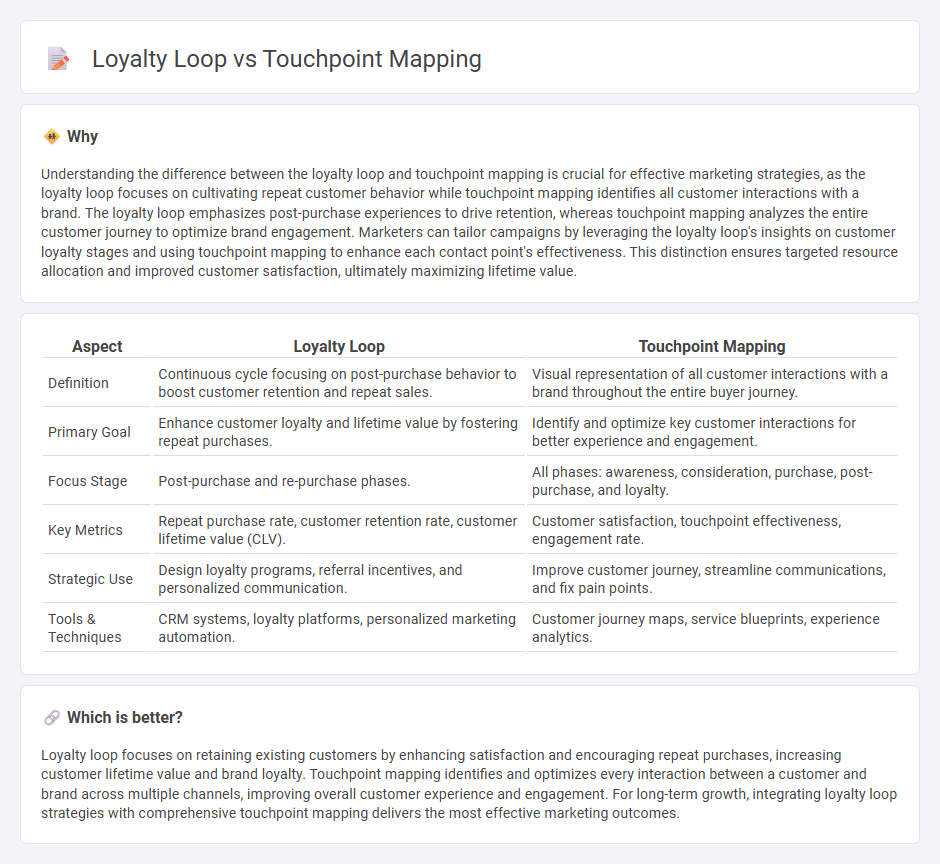
Loyalty loops focus on fostering continuous customer engagement and repeat purchases by nurturing satisfaction and trust post-purchase, while touchpoint mapping identifies every interaction a customer has with a brand throughout the entire journey to optimize each experience. Understanding the distinctions between these concepts allows marketers to tailor strategies that enhance customer retention and brand perception effectively. Explore the benefits of integrating loyalty loops and touchpoint mapping to elevate your marketing efforts.
Why it is important
Understanding the difference between the loyalty loop and touchpoint mapping is crucial for effective marketing strategies, as the loyalty loop focuses on cultivating repeat customer behavior while touchpoint mapping identifies all customer interactions with a brand. The loyalty loop emphasizes post-purchase experiences to drive retention, whereas touchpoint mapping analyzes the entire customer journey to optimize brand engagement. Marketers can tailor campaigns by leveraging the loyalty loop's insights on customer loyalty stages and using touchpoint mapping to enhance each contact point's effectiveness. This distinction ensures targeted resource allocation and improved customer satisfaction, ultimately maximizing lifetime value.
Comparison Table
| Aspect | Loyalty Loop | Touchpoint Mapping |
|---|---|---|
| Definition | Continuous cycle focusing on post-purchase behavior to boost customer retention and repeat sales. | Visual representation of all customer interactions with a brand throughout the entire buyer journey. |
| Primary Goal | Enhance customer loyalty and lifetime value by fostering repeat purchases. | Identify and optimize key customer interactions for better experience and engagement. |
| Focus Stage | Post-purchase and re-purchase phases. | All phases: awareness, consideration, purchase, post-purchase, and loyalty. |
| Key Metrics | Repeat purchase rate, customer retention rate, customer lifetime value (CLV). | Customer satisfaction, touchpoint effectiveness, engagement rate. |
| Strategic Use | Design loyalty programs, referral incentives, and personalized communication. | Improve customer journey, streamline communications, and fix pain points. |
| Tools & Techniques | CRM systems, loyalty platforms, personalized marketing automation. | Customer journey maps, service blueprints, experience analytics. |
Which is better?
Loyalty loop focuses on retaining existing customers by enhancing satisfaction and encouraging repeat purchases, increasing customer lifetime value and brand loyalty. Touchpoint mapping identifies and optimizes every interaction between a customer and brand across multiple channels, improving overall customer experience and engagement. For long-term growth, integrating loyalty loop strategies with comprehensive touchpoint mapping delivers the most effective marketing outcomes.
Connection
Loyalty loop and touchpoint mapping are interconnected by focusing on customer interactions throughout the buying journey and post-purchase experience. Touchpoint mapping identifies and analyzes key moments where customers engage with a brand, which informs strategies to enhance satisfaction and encourage repeat purchases within the loyalty loop. This integration helps marketers optimize retention, increase customer lifetime value, and build stronger brand loyalty through personalized and consistent engagement.
Key Terms
**Touchpoint Mapping:**
Touchpoint mapping systematically identifies every interaction a customer has with a brand, facilitating a comprehensive understanding of the customer journey and pain points. This strategy enables businesses to optimize customer experience by refining each contact point, enhancing satisfaction and brand loyalty. Explore how touchpoint mapping can transform your customer engagement and drive growth.
Customer Journey
Touchpoint mapping identifies all the customer interaction points across different stages of the customer journey, providing a detailed visualization of how customers engage with a brand. The loyalty loop focuses on post-purchase behaviors, emphasizing customer retention, satisfaction, and repeat buying without returning to the initial consideration phase. Explore how integrating touchpoint mapping with the loyalty loop can enhance your overall customer experience strategy.
Interaction Channels
Touchpoint mapping identifies all customer interaction channels across the buyer's journey to optimize each contact point, from awareness to post-purchase engagement. The loyalty loop centers on repeated interactions within key channels to reinforce customer retention and drive advocacy through seamless experiences. Explore the differences in channel strategies to enhance customer relationships and maximize lifetime value.
Source and External Links
Conduct a Touchpoint Mapping - Experience Dynamics - Touchpoint mapping is a service design technique that visualizes and inventories interactions between customers and a service/product, focusing on analyzing emotions, pain points, and connections throughout the entire journey rather than just listing channels or points.
Use Customer Touchpoint Mapping to Optimize the ... - Woopra - Touchpoint mapping visualizes all customer interactions from start to finish, recommending strategies such as auditing existing interactions across awareness, consideration, purchase, retention, and advocacy stages for optimization.
Customer touchpoints: How to identify them + examples - Zendesk - Businesses identify touchpoints by mapping the entire customer journey, defining personas, listing touchpoints at each stage, collecting data, and analyzing for pain points to improve and ensure a seamless experience.
 dowidth.com
dowidth.com